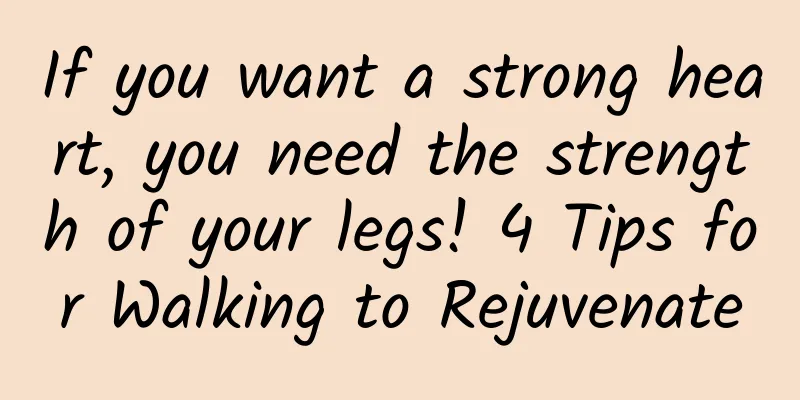If you want a strong heart, you need the strength of your legs! 4 Tips for Walking to Rejuvenate

|
To tell whether your heart is strong enough, you can look at the strength of your legs, because "feet are the second heart of the human body!" Everyone has legs and can walk, but if you walk in the right way, it can not only protect your heart, but also rejuvenate you. You may wish to learn the shortcut method from "walking method" to "walking body" to reduce waist circumference, thin legs and lose weight naturally. It can especially fight fatigue, strengthen heart and lungs and muscle strength, and create a lean, thin and beautiful body shape. A body that can walk can be healthy In recent years, walking has been regarded as a healthy method and has attracted much attention. However, you may not know that "walking" is not the same as "a body that can walk". You need a "body that can walk" to achieve such an effect. People who have a "walking body" can make full use of the structure and functions that humans are born with; on the contrary, people who do not have a "walking body" cannot make good use of their body structure and are prone to pain in certain parts of the body. 4 steps of walking rejuvenation method: relaxation → foundation → feeling → balance Becoming a "walking body" is a step towards your ideal body and can also achieve a rejuvenation effect. What is the “Walking Rejuvenation Method”? Japanese yoga teacher Miyuki Ishida said in her new book "Walking Rejuvenation": The feet are the second heart of the human body, and the lower body determines the health of the body. But, do you know how to walk? The following four steps are proposed in the article: Step 1: First, relax your body, awaken the originally dull sensory organs, and make them sensitive to the body's crookedness and discomfort. Step 2: Reorganize the lower body bones which are the "foundation" of the body. If the "foundation" is well built, the body's functions will improve and the stability of the heart will increase. Step 3: Pay attention to the feeling of your body, because the foundation of the body is the foundation of the mind. If you can feel your body leaning, you will be able to adjust yourself; on the contrary, if your foundation is unstable, your breathing will become disordered and even your autonomic nervous system will be affected. You will feel something strange in your body and your heart will become often irritable and restless. Step 4: Learn to balance. After learning how to "use force", you also need to know how to "release force". Just like breathing, "exhaling" and "inhaling" are equally important. In addition to teaching you how to walk well, this book also uses Thai therapy to relax and balance your exerted body. The adductor flexor muscles and erector spinae muscles are strong and thick muscles, and are also important muscles that are frequently used when walking. Strengthen your feet: good balance between deep and superficial muscles To strengthen the feet and waist, you need to exercise the deep muscles and create a good balance between the deep muscles and the superficial muscles. The deep muscles located inside the body and close to the bones (called inner muscles in English) are difficult to touch and feel, so they are difficult to perceive. The "deep muscles" are the first muscles to be used, including: moving the jaw, holding up the head, sitting down, crawling, and even being able to stand up. All of these require the use of deep muscles. They also become the core muscles of activity. As we age, we become old and weak and it becomes difficult to get out of bed. Even so, they are the last muscles to be used. In short, it is the muscle that helps us "carry out basic tasks of activities" throughout our lives. On the other hand, the muscles located more internally in the body, also known as "superficial muscles," are easy to touch and feel because they are on the surface of the body. The superficial muscles are the muscles that develop to help the deep muscles when infants and toddlers stand up on their own. They can also be said to be "muscles that have the task of adding value" in order to stand more steadily and move faster. Important muscles frequently used when walking: adductor muscles, erector spinae From an anatomical point of view, the adductor flexor muscles and erector spinae muscles are strong and thick muscles, and are also important muscles that are frequently used when walking. The so-called "nave muscle" is part of the gluteal muscles, connecting the deep muscles of the hip joint and pelvis, and is required to obtain stability for left and right balance to avoid swaying. Therefore, it is an important muscle in standing and walking. As for the "erector spinae", it is a long muscle from the back of the head to the pelvis. If you can use the deep muscles, you can feel the effect of walking. |
Recommend
What causes cervical erosion? Is it serious?
Cervical erosion is a phenomenon caused by ectopi...
Miley Cyrus loses weight by removing starch Rihanna loses weight by ice cream
Miley Ray Cyrus, who became famous for playing th...
Common treatments for vulvar leukoplakia
What are the common treatments for vulvar leukopl...
There are two main treatments for ectopic pregnancy
Ectopic pregnancy is a common gynecological disea...
Is obesity caused by the gluttonous monster? Beware of food addiction
Most researchers believe that 10% to 15% of peopl...
The key to effectively reducing body fat is to "shrink fat cells"
Should we lose weight or just focus on weight and...
How to prevent senile vaginitis?
We know that there are many types of vaginitis, a...
What causes menstrual cramps, sweating and vomiting?
Women have symptoms of dysmenorrhea and sweating ...
Ovarian cysts may present with a range of compression symptoms
Ovarian cysts may cause a series of compression s...
Why is the color of menstruation black and not black?
Why is the color of menstruation black and not bl...
Body Sculpting Tutorial - Slimming Arms and Triceps Stretch
The hot summer is here, and many girls have throw...
Is it easy to cure chronic cervicitis? Several effective methods for treating chronic cervicitis
Cervicitis is clinically divided into acute and c...
What are the symptoms of incomplete abortion? There are 3 major symptoms
Many women who are not ready to have children wil...
What is the high incidence of ectopic pregnancy?
What are the causes of high incidence of ectopic ...
TCM diagnosis and treatment of anovulatory functional uterine bleeding
Menstruation, as a normal physiological phenomeno...









